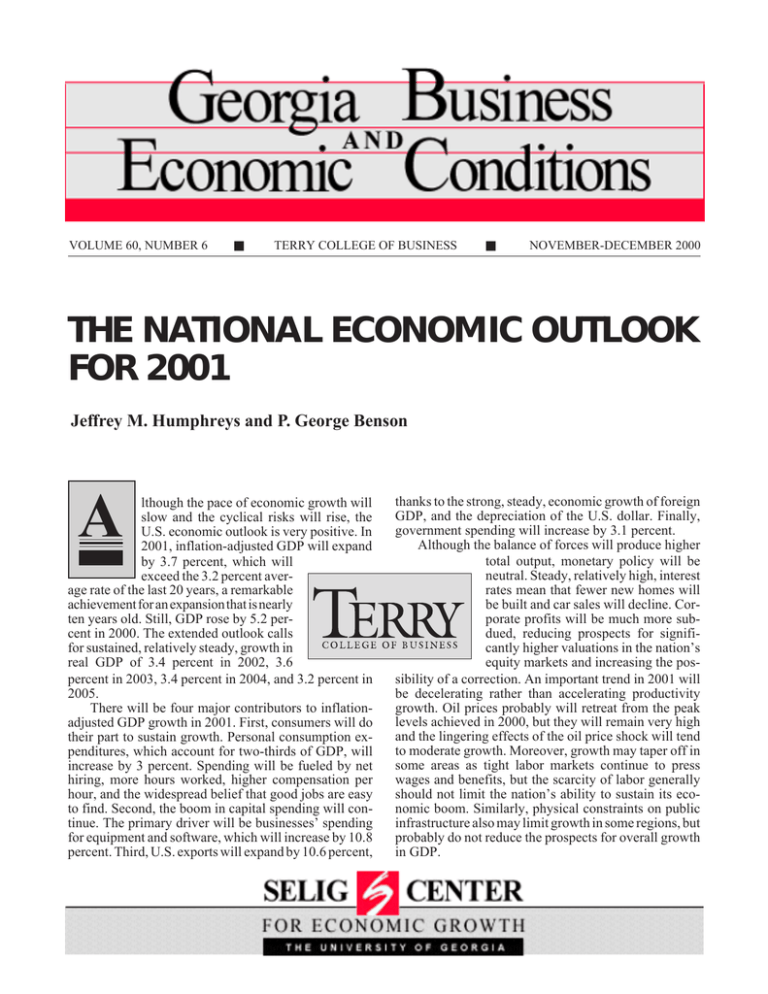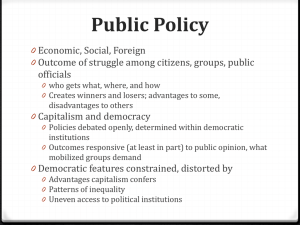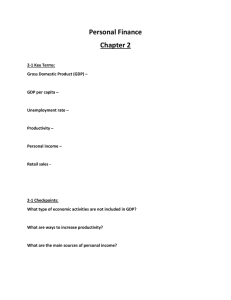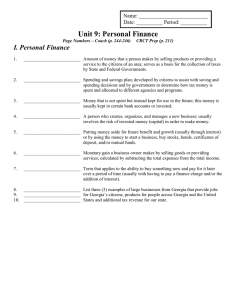Document 11133387
advertisement

VOLUME 60, NUMBER 6 ■ TERRY COLLEGE OF BUSINESS ■ NOVEMBER-DECEMBER 2000 THE NATIONAL ECONOMIC OUTLOOK FOR 2001 Jeffrey M. Humphreys and P. George Benson A lthough the pace of economic growth will slow and the cyclical risks will rise, the U.S. economic outlook is very positive. In 2001, inflation-adjusted GDP will expand by 3.7 percent, which will exceed the 3.2 percent average rate of the last 20 years, a remarkable achievement for an expansion that is nearly ten years old. Still, GDP rose by 5.2 percent in 2000. The extended outlook calls for sustained, relatively steady, growth in real GDP of 3.4 percent in 2002, 3.6 percent in 2003, 3.4 percent in 2004, and 3.2 percent in 2005. There will be four major contributors to inflationadjusted GDP growth in 2001. First, consumers will do their part to sustain growth. Personal consumption expenditures, which account for two-thirds of GDP, will increase by 3 percent. Spending will be fueled by net hiring, more hours worked, higher compensation per hour, and the widespread belief that good jobs are easy to find. Second, the boom in capital spending will continue. The primary driver will be businesses’ spending for equipment and software, which will increase by 10.8 percent. Third, U.S. exports will expand by 10.6 percent, thanks to the strong, steady, economic growth of foreign GDP, and the depreciation of the U.S. dollar. Finally, government spending will increase by 3.1 percent. Although the balance of forces will produce higher total output, monetary policy will be neutral. Steady, relatively high, interest rates mean that fewer new homes will be built and car sales will decline. Corporate profits will be much more subdued, reducing prospects for significantly higher valuations in the nation’s equity markets and increasing the possibility of a correction. An important trend in 2001 will be decelerating rather than accelerating productivity growth. Oil prices probably will retreat from the peak levels achieved in 2000, but they will remain very high and the lingering effects of the oil price shock will tend to moderate growth. Moreover, growth may taper off in some areas as tight labor markets continue to press wages and benefits, but the scarcity of labor generally should not limit the nation’s ability to sustain its economic boom. Similarly, physical constraints on public infrastructure also may limit growth in some regions, but probably do not reduce the prospects for overall growth in GDP. 2 CONSUMER MARKETS year, spending by consumers, who largely determine the economy’s path, increased by 5.1 L ast percent, which was essentially the same as the 5.2 percent increase in GDP. Income gains, the strongest labor market in a generation, recent capital gains in the stock market, homeowners’ expanding equity, easy access to credit, and low prices for manufactured goods fueled the boom in spending. Consumers nearly outspent their income gains, however; and as a consequence, the low savings rate plummeted from 2.2 percent to 0.3 percent. Sustained optimism, plentiful jobs and high rates of job growth, rising home values, and the recent performance of the stock market largely explain consumers’ increased propensity to spend. Consumer demand will continue to climb in 2001 as well. Fast-paced personal income growth will moderate only slightly and housing prices will rise steadily. Substantial wage and salary gains will allow households both to increase their savings and to spend more. Also, more jobs and a sense of job security will keep households comfortable about ramping up spending. In con- GEORGIA BUSINESS AND ECONOMIC CONDITIONS November-December 2000 Volume 60, number 6 SELIG CENTER FOR ECONOMIC GROWTH P. George Benson Dean Jeffrey M. Humphreys Director Lorena M. Akioka Editor Beata D. Kochut Research Coordinator Ian Armit Information Analyst GEORGIA BUSINESS AND ECONOMIC CONDITIONS (ISSN 0297-3857) is published bimonthly by the Simon S. Selig, Jr. Center for Economic Growth, Terry College of Business, The University of Georgia, as a service to the business and academic communities. Signed articles reflect the author’s opinion but not necessarily those of the Selig Center for Economic Growth, Terry College of Business , or The University of Georgia. This publication is sent free of charge upon request. Manuscripts and letters to the Editor should be sent directly to us. Postmaster send address changes to: Selig Center for Economic Growth, Terry College of Business, The University of Georgia, Athens, GA 30602-6269. Periodicals postage paid at Athens, Georgia trast, high oil prices and high interest rates may retard spending growth, and the stock market probably will not perform as well as it has in recent years. In addition, Americans will be slightly less optimistic about the economy, so consumers’ inflation-adjusted expenditures therefore will increase by only 3 percent, and account for only 55 percent of the year’s increase in GDP. In 2001, disposable personal income will increase by an inflation-adjusted 3.1 percent (or by an unadjusted 5.7 percent), both of which are only slightly lower than the growth rates posted in 2000. It is anticipated that wage and salary pressures in the already-tight labor market will continue to boost income substantially, but there are few signs of acceleration in wage and salary increases. Nonetheless, the projected 4 percent increase in hourly compensation should be a very potent force, particularly since the average number of hours worked per week will rise. Also, wages are likely to grow faster than fringe benefits. The slowdown in employment growth and the performance of the stock market will provide less support to income growth, however. Consumer credit outstanding will expand by 9.4 percent in 2001, compared to 10.9 percent in 2000. High interest rates, less wealth creation in the stock market, and consumers’ slightly less upbeat assessment of current and future conditions are among the factors that account for the slightly slower rate of growth of consumer borrowing. The savings rate will creep up from 0.3 percent in 2000 to 0.6 percent in 2001. Even though consumers’ euphoria will fade slightly, several confidence builders will keep things rosy. Consumers will remain optimistic because of the nation’s very solid labor market, including jobs added in 2000, steady increases in the selling prices of existing homes, continuing employment gains, and the low unemployment rate. This confidence could be shaken by any sustained drop in the stock market or by additional oil shocks, however. Although housing sales and starts declined from last year’s peak levels, recent turnover and continuing healthy housing markets should help to support higher demand for many household goods and services. Moreover, home values are at a record levels and prices of existing homes will climb steadily higher in 2001. Most of the 67.2 percent of those who own homes therefore will see their housing investments increase in value, adding considerably to their net worth. In the coming year, consumers’ spending for services will increase much faster than spending for goods. Among services sectors, spending for recreation will expand the fastest, followed by spending for transportation, medical care, housing, and household operations. Among goods, spending for nondurables will grow faster than spending for durables, though people will buy fewer new cars in 2001. The recent boom in home sales will boost consumers’ purchases of furniture and other household items. Outlays for clothing, shoes, food, and beverages will increase moderately. Georgia Business and Economic Conditions 3 Deluxe Edition Buying Power Time Series on CD-ROM The Selig Center announces the debut of its new CD-ROM, which includes the entire buying power time series for 1990-1999, and projections for 20002001. Estimates of racial and ethnic purchasing power are available for the nation and all fifty states. Georgia data are delineated by county. The CD also includes the electronic version of the 20002001 Georgia Statistical Abstract. The CD is available for purchase exclusively from the Selig Center for $50. To order your copy, please use the order form on page 11 . nesses. Increases in retail sales will boost retail employment. The transportation, communications, and public utilities sector will see moderate rates of annual employment growth, largely because surging demand for transportation and telecommunications services will offset the decline in utilities employment. Increased demand for services will add jobs in state and local government, but fewer jobs will be available with the federal government. High oil prices will stimulate oil and gas extraction, boosting employment in the nation’s mining industry. Because conditions will be less positive for banks, insurance companies, and real estate firms, employment in these areas will increase very slightly. Manufacturing output is expected to increase by 4.2 percent in 2001, but sectoral employment probably will decline slightly. CORPORATE PROFITS economy experienced a profits recesT hesionU.S.in 1998, but corporate profits surged by LABOR MARKETS n 2000, civilian household employment rose by 1.6 percent and the monthly unemployment rate averaged 4.1 percent. In 2001, employment growth will ease slightly as the economy slows. Total civilian employment will rise by 1.1 percent or by about 1.4 million jobs, and the unemployment rate will rise to 4.3 percent. The new forecast means that about 117,200 jobs per month will be created, which is about 87 percent of the average monthly increase measured over the last ten years. About half of the projected increase in the unemployment rate (from 4.1 percent to 4.3 percent) will be due to slower employment growth and about half will be due to labor force growth. The civilian labor force will grow by 1.3 percent, reflecting 1.1 percent growth in the working age population and an increase in labor force participation of 0.2 percent. The increased participation rate stems from intense efforts to recruit nontraditional workers in addition to the lure of higher wages and benefits. Compensation per hour rose by 4.6 percent in 2000 and will rise by 4 percent in 2001—a projection that is based on existing labor shortages, not expectations of higher inflation. Average hourly earnings will increase fastest in the financial services and other services sectors; moderately in the retail, construction, and manufacturing sectors; and relatively slowly in the mining and utilities sectors. Despite this, productivity gains will hold the increase in unit labor costs to 0.7 percent. Private nonfarm productivity, which rose by 4.2 percent in 2000, will rise by 3.3 percent in 2001. Employment will grow strongly in the nation’s services-producing industries, however. Forces behind this growth include increasing numbers of households and businesses, favorable demographic and social changes, consumers’ reliance on commercial sources for domestic and personal services, and more outsourcing by busi- I November-December 2000 10.4 percent and 12 percent in 1999 and 2000, respectively. After-tax corporate profits will increase by 2.6 percent in 2001. The tight labor market, slightly slower productivity growth, high oil prices, higher commodity prices, and a reduced pace of domestic economic growth account for the forecast. Domestic labor costs probably will increase nearly as fast as U.S. companies can raise prices and increase productivity. Demand growth, however, will help to compensate for thinner profit margins. The large and growing value of unused stock options, which have become a general form of employee compensation, is a looming threat to corporate profits because the options are not expensed until exercised. Because corporate profits already are very high, the effects of a slowdown in the profits growth rate will not be very drastic; however, it will make companies scrutinize spending a little more carefully. Also, until corporate profits pick up again, stock prices probably will experience percentage gains that are smaller than the 5.5 percent gain expected in nominal GDP in 2001. Boosted by the increased use of new technologies and intense competition, businesses’ spending for new investment will continue to zoom, but the profits slowdown will diminish year-over-year percentage gains. The longterm forecast calls for after-tax corporate profits to expand by 3.2 percent and 2.9 percent in 2002 and 2003, respectively. BUSINESS INVESTMENT consumer spending is the most powerA lthough ful component of GDP, investment spending has been growing the fastest. In 2000, businesses increased their inflation-adjusted spending on productivity-enhancing equipment by 16.1 percent, but because corporate profits aren’t growing as fast, spending on capital goods will taper off in 2001. Inflation- 4 adjusted expenditures for producers’ durable equipment will rise by about 10.8 percent, or only about two-thirds of last year’s 16.1 percent increase. But even this slower spending, which is vital to sustaining the expansion, will grow almost three times faster than GDP. Businesses increased their spending on informationprocessing equipment by 25.6 percent in 1999 and by 26.9 percent in 2000. Such spending will increase by 16.8 percent in 2001 primarily because computers are cheaper and better, businesses are focused on productivity, and everybody wants the latest technologies. Inexpand 2001, spending for industrial equipment will by 5.2 percent. Capacity utilization in domestic manufacturing will be 81.5 percent, and this is high enough to justify the larger outlay for durable equipment. Also, intense domestic and global competition and consumers’ price resistance will encourage American manufacturers to lower costs and invest in better equipment to help them improve profit margins. The projected 0.7 percent increase in unit labor costs will trigger more spending on labor-saving machines and technologies. Despite these strong fundamentals, businesses’ spending on equipment and other forms of nonresidential fixed investment will grow more slowly in 2001 than in 2000. The slower growth of corporate profits, high interest rates, and less upward momentum in the stock market will retard the growth of nonresidential fixed investment and dampen business peoples’ confidence in the economy. Spending to increase capacity often depends on the rate at which output expands, and U.S. GDP growth will slow. Demand for machinery used in residential construction will decline as building activity stagnates or falls. Finally, improving economic opportunities in the rest of the world may make it more difficult for the U.S. to attract foreign capital. GOVERNMENT EXPENDITURES fiscal policy will be slightly stimulative, F ederal with real expenditures rising by 1.9 percent. A 2.4 percent rise in defense spending will reinforce a 1.2 percent increase in non-defense spending. Cyclical increases in revenues will continue to generate surpluses in the current and coming fiscal years. The surplus—unified budget—will rise from its FY 2000 level of $231.9 billion to $318.5 billion in FY 2001, or 15.6 percent of total receipts. In FY 2002, the surplus will decline to $296.5 billion, or 14 percent of total receipts. The surplus will be $249.9 billion in FY 2003. Inflation-adjusted spending by state and local governments will increase by 2.7 percent—4.8 percent in nominal dollars—driven by higher spending on construction, larger school enrollments, and larger prison and Medicaid populations. Transfer payments to persons receiving Medicaid will see the highest rate of growth. Many state and local governments also will spend more to provide services to larger populations. MONETARY POLICY forecast assumes that the Federal Reserve’s T heactions will be neutral in 2001; essentially, the increase in oil prices and other energy costs have put the Fed on hold. The rate of growth of the money supply, M3, will increase, from the 8 to 10 percent rates reported during 1997-1999, to about 12 percent in 2001. Although GDP growth will slow, recently completed monetary tightening will not end this long, strong economic expansion. Despite high interest rates, many of the forces that have held inflation to the lowest levels in more than thirty years have weakened or reversed, contributing to slightly higher inflation. Inflation bottomed out in 1998 when the consumer price index rose by only 1.6 percent. Partly due to higher energy prices, the CPI rose to 2.2 percent in 1999 and to 3.2 percent in 2000; and if oil prices behave as expected, the index will jump up 2.5 percent in 2001. Tight labor markets and slightly slower productivity growth will be the two primary forces behind inflation. Widespread labor shortages will force employers to offer higher wages and benefits in order to meet workers’ aggressive demands. As wage increases surpass smaller productivity gains, businesses will raise the prices of their goods and services. In 1998, the nominal trade-weighted value of the U.S. dollar was 19 percent higher than in 1995, primarily because it was buttressed by economic strength and continuing capital flight from distressed areas to safe havens in this country. This substantial appreciation reduced inflation by lowering the prices of imported goods, thereby preventing U.S. manufacturers from raising prices even though domestic consumer markets werevery good. The strong dollar also lowered external demand for American-made products. The situation in the currency markets changed in 1999. As global economic conditions improved, so did investment opportunities in other countries. Foreign investors therefore were no longer as willing to finance the large U.S. current account deficit. Consequently, the trade-weighted value of the dollar depreciated by 2.3 percent, transforming a force that had been countering inflation intoone that reinforced it. In late 1999 and early in 2000, the dollar stabilized and appreciated slightly (its trade-weighted value rose by 1.4 percent in 2000), but by the third quarter of 2000, pressures from the current account imbalance again pushed the dollar back down. In 2001, the dollar’s trade-weighted value will decline by 4.5 percent. The gradual depreciation will continue through 2005, with percentage drops of 2.6 percent in 2002, 1.3 percent in 2003, 1.4 percent in 2004, and 1.4 percent in 2005. INTERNATIONAL TRADE year, real imports increased by 13.7 percent L ast and real exports grew by 9.7 percent, cutting 1 percent from the rate of GDP growth. The curGeorgia Business and Economic Conditions 5 rent account deficit reached $444 billion. In 2001, the gap between export growth and import growth will narrow as the paces of both U.S. and foreign economic growth converge. Real imports and exports will increase by a respective 8.9 percent and 10.6 percent in the coming year. Real net exports will cut GDP growth by only 0.2 percent; and the current account deficit will rise to a $495 billion, or 4.7 percent of GDP. In 2001, export markets will be strongest for computer equipment and other capital goods. Foreign demand for consumer goods, industrial supplies, and services will increase relatively strongly. Moderate gains are expected for food, although exports of motor vehicles and parts will decline. HOUSING MARKETS ctivity in the nation’s homebuilding industry peaked in 1999, when 1.7 million housing units were built. Housing starts declined to 1.6 million units in 2000, a drop of 5.5 percent. Although the Federal Reserve is not expected to raise interest rates, the lagged effects of recent actions will reduce activity in the nation’s housing market in 2001. The new construction forecast calls for housing starts to decline by 8.6 percent to 1.5 million units. Activity will drop again to about 1.4 million units in 2002, where it is expected to remain through 2005. Nationally, sales of existing homes are expected to drop by 5.7 percent, but the median sales price of existing homes will rise by 4 percent in 2001, or by about $5,500 on the typical $143,200 home. The median selling price of new homes will rise from $164,800 in 2000 to $174,100 in 2001. Because mortgage rates were very low for a long time and the levels of activity already are very high, even steady mortgage rates will cut demand for new and existing homes. The other fundamental determinants of demand for single-family homes—growth in employment, population, and personal income—should produce a lower but still historically strong level of homebuilding. Solid growth in employment increases the demand for rental housing at first, but its lagged effects on single-family homebuilding will be crucial in the aging economic expansion. Many factors will increase demand for home renovations, an activity that is less cyclical than new construction because the peaks are less pronounced and tend to occur later. Since this business cycle has seen booming sales of existing houses, owners are likely to invest in repairs and improvements. Owners can readily afford to do this, thanks to appreciating values that have increased equities, and refinancing that has lowered monthly payments. A CRUDE OIL MARKETS sliding by 8 percent in 1997, refiners’ A fter acquisition costs per barrel of crude petroleum plummeted by 34 percent in 1998. In the first November-December 2000 quarter of 1999, the annual average price of a barrel of crude fell to $11 per barrel. The collapse of crude oil markets that began in early 1997 and made gasoline cheaper than bottled water reflected several problems. Chronic structural excess in worldwide production capacity, plus the unwillingness of some OPEC countries to stay within their established quotas, flooded the market. Economic and financial turmoil in developing nations cut oil consumption and demand in those areas. Mild winters in Europe and the U.S. also left crude oil stocks high. Market conditions changed abruptly in the second quarter of 1999. An agreement among OPEC members on production cutbacks that were reinforced by actions of non-OPEC oil exporting countries, particularly Russia and Mexico, were the initial factors that caused oil prices to soar. In the fourth quarter of 1999, the annual average price of a barrel of crude climbed to $23 per barrel, or 109 percent higher than the price that prevailed in the first quarter of the year. This large percentage gain, however, is coming off an artificially low base. Since the doubling of oil prices in less than a year simply returned oil prices to where they were prior to the financial crises in Asian and other emerging markets, the oil price increase did not hamper GDP growth in 1999, though it did boost inflation. In 2000, global economic growth, OPEC resolve, and declining inventories erratically pushed oil prices above pre-Asian crisis levels. Oil prices averaged $27 per barrel during the first nine months of the year, or about 18 percent higher than in late 1999, which means that this will trim about 0.7 percent from GDP growth in 2001. Market conditions favor high oil prices in 2001, but prices are expected to retreat from the peaks attained in 2000. Demand growth will remain strong and capacity growth will be relatively low. Discipline within the OPEC cartel is difficult to predict, but should be maintained if neither Iraq nor Venezuela raises production substantially. Inventories are expected to remain very tight, so energy markets will be highly sensitive to unexpected shifts in supplies or political instability in oil-producing nations. The most likely capacity additions include new non-OPEC production from deepwater off Africa and Brazil. Some OPEC countries and Mexico also plan capacity expansions. The possible completion of the CPC pipeline from the Caspian Sea would add to energy supplies, and the easing of UN sanctions on Iraq may help, too. The risk of a U.S. oil-price recession is low if oil prices average less than $30 per barrel in 2001. Expect the oil shock to cause a recession if prices average $40 per barrel or more, however, particularly if the Fed hikes interest rates to stop an oil-led inflationary spiral. ■ 6 INTERNATIONAL ECONOMIC OUTLOOK FOR 2001 Jeffrey M. Humphreys and P. George Benson T he outlook for the global economy calls for slightly slower GDP growth, with many countries operating closer to their potential rate of non-inflationary growth. With the exceptions of Japan and Russia, expansions of inflation-adjusted gross domestic product are well established in most of the world’s larger economies. In 2001, GDP growth will decelerate in the United States, Canada, and Mexico, but growth will accelerate Central and South America. Almost all European nations will experience steady to slightly lower rates of GDP growth. Japan’s economy probably will contract slightly in 2001, but moderately strong growth will continue in most other Asian countries, and China’s economy will continue its surge. After rising by 2.2 percent in 2000, foreign prices will rise by 3.7 percent in 2001. Western Europe, Asia, Canada, and Russia will enjoy larger current account surpluses. In contrast, the United States, Mexico, and most countries in Latin America and Eastern Europe will post larger current account deficits. CANADA 2001, Canada’s domestic consumer market be the primary force powering inflationI nwill adjusted GDP growth of 3.5 percent. Labor market conditions are good and personal income is rising, providing consumers both the confidence and the means to spend more. Fiscally healthy, the country is running a budget surplus, which will allow the government to spend more and cut taxes. The Canadian economy will expand less rapidly in 2001, however. When the economy grew by nearly 5 percent last year, the Bank of Canada raised interest rates, and now it probably will maintain its tight monetary stance because the economy is operating close to its non-inflationary limits. The slower expansion of the U.S. economy will help the Bank to achieve its goal of reducing inflationary pressures by lowering domestic GDP growth. Because the American economy will be less vigorous, exports to the United States—which account for about 85 percent of Canadian exports—will contribute less to economic growth. Since most of Canada’s vehicle output goes to the U.S., an expected slump in American auto sales will hurt auto production in Canada in 2001. Modest appreciation of the Canadian dollar relative to U.S. dollar also will discourage exports to the U.S. Imports of consumer goods are expected to surge, further reducing the contribution of net exports to Canada’s GDP. Economic growth in Europe, Latin America, and Asia and rising commodity prices will reinforce exports, partially offsetting the effects of the American market’s slower growth. MEXICO soaring by nearly 7 percent in 2000, Mexico’s A fter GDP will expand by 4.5 percent in 2001. As U.S. economic growth slows, domestic consumption and domestic investment will contribute somewhat more to Mexico’s GDP growth and exports will contribute somewhat less. The country’s strong job market will keep consumers very confident, which will encourage domestic demand. Vincente Fox’s victory in the recent presidential election, high levels of capacity utilization, the more broadly-based use of new technologies, and shortages of skilled workers will boost businesses’ spending for plants, equipment, and other types of capital investment. High oil prices will help to reinforce GDP growth and will bolster public finances, so fiscal policies probably will encourage expansion. Economic recovery and expansion in Latin America and many other emerging markets will stimulate trade and foreign investment. Slower economic growth in the U.S. will be the primary factor that will limit growth in the short term, Georgia Business and Economic Conditions 7 because exports, tourism, and foreign investment derive much of their support from the strength of the American economy. Banco de Mexico’s tight monetary policy will continue, but the overall effect of tight money will be scant because very little activity is financed by credit. High interest rates, however, will restrain demand for big-ticket consumer goods, such as automobiles. Despite rapid employment growth, there is no shortage of unskilled or semi-skilled workers. Favorable demographic trends and the re-entry of workers from the country’s large informal economy will assure an adequate labor supply. There is a growing shortage of skilled workers, however. The country’s short-term and long-term prospects are limited by an education system that does not produce enough technically proficient workers, which is a major deterrent to companies that want to expand or establish operations in Mexico. Crime is another problem that must be addressed if the country is to continue to attract foreign investments and tourists. UNITED KINGDOM expanding by 3 percent in 2000, GDP will A fter expand by 2.7 percent in 2001. Substantial monetary policy tightening curtailed inflation last year, so little, if any, additional monetary tightening will be needed. Decelerating GDP growth should allow inflation to settle to 2.7 percent in 2001. Fiscal policy will remain neutral, or will provide only slight stimulus. Despite high interest rates, consumer spending will strengthen because the British will be encouraged by personal income growth, rising home prices, and 20year lows in unemployment. Homebuilding and real estate activity will be very strong, but probably will not climb much higher in 2001. The cyclical upturn in manufacturing activity will continue, reflecting the ongoing growth of domestic demand and sustained global economic growth. Tight labor markets and rising capacity utilization also will encourage spending for capital equipment. EUROPEAN UNION COUNTRIES Germany ■ Germany’s economic expansion will depend less on exports and business spending for investment and more on spending by domestic consumers. Domestic consumer spending will strengthen, benefiting from wage gains that exceed the rate of inflation and tax cuts that increased disposable personal income. More competition in retailing also will encourage Germans to spend more. Also, the European Central Bank will shift from a restrictive monetary stance to an essentially neutral position, keeping key interest rates steady in 2001. November-December 2000 Tax cuts and job growth should prevent an oil-pricewage spiral. Also, there is still a great deal of slack in the country’s labor market. But the building boom that followed in the wake of reunification will prevent the construction sector from contributing to growth now. France ■ This nation will see its GDP rise by 3.1 percent in the coming year. There is considerable spare capacity in the general labor market, but the shortened workweek (from 39 hours to 35 hours) created a tighter market for highly skilled workers. Moderate wage gains and low inflation will increase real disposable personal income. Employment will expand, and high-tech and service sector job growth will be strongest. Sanguine consumers are expected to draw down their savings to buy big-ticket durables. Tax cuts will power consumer spending, too. Industrial production will benefit from the strong domestic consumer market. Businesses’ spending for investment should receive a boost from record-high levels of capacity utilization, but the stimulus will be reduced by the lower growth of corporate profits. A stronger Euro coupled with slower economic growth in the U.S. will reduce net exports’ contribution to France’s GDP growth, however. Italy ■ Italy’s GDP grew by 3 percent in 2000 and this pace will be maintained in 2001. From an historical perspective, interest rates and inflation will be very low. Businesses’ confidence in the economy should be high, encouraging more spending for investment. The labor market is one of the weakest in the European Union, but job creation is expected to accelerate. Consumer spending therefore will strengthen, and the economy will benefit from tax reductions. Less positively, net exports will suffer from slightly slower growth of Italy’s major trading partners. Due to its tight fiscal stance, the country will be operating far below its potential output. Spain ■ Spain continues to be one of the fastgrowing countries in the European Monetary Union, with an expected GDP growth of 3.5 percent in 2001. The abundance of labor should help to restrain inflation, but inflationary pressures are building nonetheless. Income and job growth and high consumer confidence will power households’ spending. Business investment will be heavy due to rising capacity utilization and hefty profits. Tourism will benefit from improved economic conditions in EMU countries. Spain’s economy will continue to benefit from recent market-oriented reforms, including deregulation, massive privatization of state-owned enterprises, structural reforms, more flexible labor markets, more competitive product markets, and more open capital markets. The recent focus on vocational education, spending on research and development, high technology, and increasing the mobility of labor are good signs for its future economic growth. 8 cal problems, including crime, corruption, and the “culture of nonpayment” have been ignored. Obsolete and grossly inefficient enterprises have not been shut down. The country is experiencing a substantial brain drain, and the education system is deteriorating. Given these problems, it is difficult to predict both shortterm and long-term economic performance. Nonetheless, net exports should make a larger contribution to 2001’s GDP. Sustained growth of the economies of Western and Central Europe and high prices for oil, natural gas, metals, and other export commodities will boost net exports. High prices for imported goods will continue to encourage Russians to purchase more domestically made goods, thereby boosting manufacturing. Foreign direct investment should be larger than in 2000, but is very small relative to the size of the economy. In 2001, GDP may expand by 4 percent, but the inflation rate probably will remain at about 14 percent. Fixed capital investment will continue to be extremely low, too. its zero interest rate policy by raising short-term rates to 0.25 percent, a circumstance that probably will be unchanged in 2001. The failure of free money to invigorate spending reflects several considerations. First, a recession mentality keeps businesses and consumers from spending and banks from lending. Second, businesses continue to downsize and restructure. Finally, because the economy is operating far below potential, deflationary pressures are strong. Monetary policy therefore will focus on expanding the monetary base to counter deflationary pressures. Japanese households have the means to spend substantially more, and a sustained decline in the high savings rate would stimulate overall economic activity. Unfortunately, consumers’ propensity to save is unlikely to decline, and could increase. Rising unemployment rates, reduced compensations in the form of smaller bonuses, underfunded pensions and life insurance plans, corporate downsizing, and job insecurity will encourage savings rather than spending. In 2001, Japan’s economy will be very fragile, and small shifts in confidence may well determine whether or not the economy contracts or expands. Also, the country’s massive public debt increases the risk of a significant financial crisis. JAPAN CHINA RUSSIA GDP expanded by almost 5 I nflation-adjusted percent in 2000, but fiscal, structural, and politi- 1998, Japan’s GDP dropped by 2.8 percent, but I naggressive fiscal stimulus and an improving global economy allowed it to inch upward by 0.2 percent in 1999 and by another 2 percent in 2000. The GDP outlook in 2001, however, hinges on a delicate balance of positives and negatives. True recovery remains elusive because there are still far too many regulations, bad loans, unprofitable enterprises, and labor market rigidities. Fortunately, corporate and government restructuring is accelerating and the economy is embracing information technology, improving the medium- and long-term outlooks considerably. The dislocations created by restructuring, high oil prices, and the slower growth of the U.S. economy will reduce GDP by a fraction of a percentage point in 2001. Japan’s high and rising public debt will force its government to shift from a stimulative to a contractionary fiscal policy in 2001. Last year, the Bank of Japan abandoned real GDP expanded by about 8 percent in C hina’s 2000 and will grow by the same percentage in 2001. Expanding exports and larger inflows of foreign direct investment will be the primary forces powering growth. Although China avoided the financial and economic crises that affected most emerging markets, rapid restructuring of state-owned enterprises and other parts of the economy worsened unemployment. To stimulate job creation, the Chinese government will continue to pursue fiscal and monetary policies that stimulate domestic demand. Another objective of monetary policy will be to counter deflationary forces. (The deflation rate was 0.8 percent in 1998 and 1.4 percent in 1999.) Inflation was 0.5 percent in 2000. Given the combination of easy money and improved capacity utilization, 1.8 percent inflation is projected in 2001. ■ Georgia Business and Economic Conditions 9 RISKS TO THE BASELINE FORECAST S ince the global economy reached the summit of the current economic cycle in 2000, the downside risks to the baseline forecast will rise in 2001. The probability of a marked slowdown in growth or an outright recession is 40 percent. Oil prices that are persistently higher than forecast, especially when coupled with rising unit labor costs, could produce a hard landing for corporate profits and the economy. Capital spending would be cut just as the lagged effects of monetary tightening by the Federal Reserve, European Central Bank, and the Bank of Japan are bringing down the rate of global economic growth. A related risk is the possibility of substantially lower equity prices because global equity markets are not priced for a downturn in corporate profits. In a sustained “bear” market, wealth-dependent consumers would reallocate larger proportions of their current incomes from spending to savings. The slowdown in consumer spending would reinforce the decline in corporate profits, continuing the downward cycle in economic activity. Also, aggressive tightening of monetary policies by central bankers could derail global growth. Higher borrowing costs and tight credit would take their toll on corporate profits, capital spending, investors’ confidence, equity prices, and consumers’ outlays. ■ ■ November-December 2000 10 GEORGIA ECONOMIC OUTLOOK 2001 ATLANTA December 6, 2000 Georgia World Congress Center COLUMBUS January 12, 2001 Columbus Convention & Trade Center AUGUSTA January 19, 2001 Radisson Riverfront Hotel MACON January 31, 2001 Centreplex SWAINSBORO January 23, 2001 East Georgia College SAVANNAH January 25, 2001 DeSoto Hilton Hotel ALBANY December 13, 2000 Merry Acres Restaurant THOMASVILLE December 12, 2000 The Plaza Restaurant B RUNSWICK January 26, 2001 The King and Prince For information about these events , call (706) 542-1964 Office of Executive Programs Terry College of Business, The University of Georgia Georgia Business and Economic Conditions FOR SALE PORTABLE RESEARCH ASSISTANT Do you want easy access to data about Georgia? Do you want even more in-depth buying power data? Then you need the deluxe edition of the 2000-2001 Georgia Statistical Abstract. Priced at $50, this special package includes the well-recognized data book and a brand-new CD-ROM that contains EXCEL and text files for all 400-plus pages of the Abstract, with links in each chapter to the Selig Center’s web site (www.selig.uga.edu) for table updates as information becomes available. The CD also includes the complete buying power time series for 1990 through 2001. Data for Whites, African Americans, Hispanics, Asians, and Native Americans are given for all fifty states, and Georgia data are delineated by county. The deluxe edition is available now, so order yours today. ORDER FORM ______ copy of the Deluxe Edition 2000-2001 Georgia Statistical Abstract @ $50 Georgia residents ADD your applicable county tax County tax rate x purchase price TOTAL Name E-mail Address City State ❏ Bill me ❏ Check enclosed payable to Selig Center, UGA Credit Card Number ZIP ❏ VISA ❏ MasterCard Expiration Date Name on Card Mail or fax to: Selig Center for Economic Growth, Terry College of Business The University of Georgia Athens, GA 30602-6269 Phone (706) 542-4085 FAX (706) 542-3858







